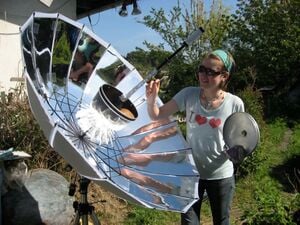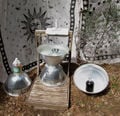
A parabolic solar cooker is essentially a solar energy concentrator used to cook food or pasteurize water. Parabolic designs have been used for centuries. The idea to concentrate light using curved mirrors was developed by the Greeks, Aztecs, Incas, Romans and Chinese. The Incas used bronze and gold for their mirrors and they built structures that were several stories high. This technology seems to have appeared around the same time for each of the civilizations.
There are many designs and models for parabolic solar cookers. Some are made with locally gathered scrap materials while others are manufactured using highly machined, durable but more expensive materials. Here are links to and photos of a number of parabolic solar cooker designs.
Danger from concentrated sunlight[edit | edit source]
This is not an inherently "fry and die" issue, the main hazards from solar concentrators, is the concentrated light it's self - which is highly unlikely to be an issue. There is the reflected light from both shiny and matt black objects, as UV light reflects off almost every material and colour with almost the same intensity. AND the concentrated light from the "illuminated object" can be VERY bright and VERY intense.
When using solar concentrator cookers, depending upon the degree of concentration, and the degree of brightness in the reflection - from the very intense concentrated sunlight - I recommend Shade 3, 5, 7 or even shade 9 safety glasses / oxygen acetelyne welding goggles or welding helmet type shade lenses.
With the lowest level concentrators - say 5 to 10 x - a good pair of UV and IR protection rated sun glasses will be fine. With concentrators achieving focal point intensities of 50 to 300 suns (small to medium satellite dishes covered in mirror tiles) proper industrial level / gas welding / arc welding lense - eye protection (cheap welding helmet) is basically mandatory.
The light is just too intense and it just hammers your retinas. Think "snow blindness" - with the sun shining on your face and sun mostly reflecting off the snow - well snow reflects up to nearly 90% of the suns UV light, and this can cause eye damage.
When you look at the sunlight that has been concentrated 5, 10, 50, 100, 300 times etc., and is reflecting off objects - including matt black paints etc., absorb almost NO UV, and off any objects almost all the UV is reflected - so your getting 5, 10, 50, 100, 300 x the amount of natural levels of UV coming into the eyes and baking the retina.
It's like being punched in the eye balls - it's just far too strong to look at - without eye protection.
https://en.wikipedia.org/wiki/Photokeratitis
Any intense exposure to UV light can lead to photokeratitis. In 2010, the Department of Optometry at the Dublin Institute of Technology published that the threshold for photokeratitis is 0.12 J/m2. (Prior to this, in 1975, the Division of Biological Effects at the US Bureau of Radiological Health had published that the human threshold for photokeratitis is 50 J/m2.) Common causes include welding with failure to use adequate eye protection such as an appropriate welding helmet or welding goggles. This is termed arc eye, while photokeratitis caused by exposure to sunlight reflected from ice and snow, particularly at elevation, is commonly called snow blindness. It can also occur due to using tanning beds without proper eyewear. Natural sources include bright sunlight reflected from snow or ice or, less commonly, from sea or sand. Fresh snow reflects about 80% of the UV radiation compared to a dry, sandy beach (15%) or sea foam (25%).
These shade 3 to 5 welding lenses (anti arc flash glasses and oxygen acetylene welding glasses) and even darker arc welding lenses, are designed to filter out all Ultra Violet and Infra Red light and to significantly reduce glare or the light intensity to safe viewing levels.

A parabolic cooker concentrates sunlight. Ordinary sunlight is already dangerous (if the sun is viewed directly without protection) so concentrated sunlight can be much more so. (There is a story that someone in the USA damaged their eyes in this way.[verification needed])
The larger the parabola, the greater the danger.
Ways of reducing the danger include:
- Safety rules.[1]
- Design. Note that these mostly reduce the danger rather than eliminate it:
- Appropriate shielding.
- Putting the focal point inside the parabola (deep dish focus), so someone would have to put their head inside to expose themselves to danger. (There is still a danger if someone unwisely checks a problem or tries to do maintenance while the parabola is pointed towards the sun, or if children are playing.)
- Using a physical barrier to prevent people going near the danger point, and being able to openly observe the concentrated light or it's reflection.
- A table to protect the cook from burns and dazzles.[2] (How does this work? It obviously can't block too much, or it will block the sun from the doing its work.)
- Designing the parabola to avoid a small sharp focal point. This requires that the cooking vessel have a relatively large surface area to catch the reflected rays. This would make it more likely for someone to be struck by the focused rays, but less damaging if it actually happened.[3]
- Maximizing the efficiency of absorption by the cooking vessel (it would be expected that making it matt black is the most important thing)
- Four design methods to improve saftey are described at Wikia:Solarcooking:Satellite dish.
The risk can be reduced but not eliminated. Other solar cooker designs have much less risk, and are probably a better option in situations where they can provide enough heat.[verification needed] Alternatively, integrated cooking and improved cookstoves with fuels from waste biomass may be safer options which use only modest amounts of resources.
Are there other solar cooker designs that can provide comparable high levels of heat but more safely, without being too expensive?[expansion needed] I made a pseudo compound parabolic dish that concentrates the light down at the bottom of the dish and gives a bit longer cook time than a parabolic dish. It worked well. I tested a winston w dish in software and that indicates MUCH longer cook time with good concentration amd a soft focus.
Gallery[edit | edit source]
-
Fig 1: Grilling meat with Parabolic Solar Cooker
-
Fig 2: Boiling water with an aluminum foil covered umbrella
-
Fig 3: Boiling water in the Himalayas
-
Fig 4: Sunbrella
-
Fig 5: Stadium Light Solar Cookers
-
Fig 7: Papasan Chair Solar Cooker
-
Fig 10: Some parabolic solar cookers from Cal Poly Humboldt
Notes[edit | edit source]
- ↑ E.g. Safety Rules (from the AMSI Solar Cooker Project)
- ↑ http://solarcooking.org/images/gallery-para.htm Parabolic Cookers] (The Solar Cooking Archive)
- ↑ This is just my (Chriswaterguy's) idea. When testing the parabola, it should not create an intense bright spot, but rather a slightly diffuse bright spot (but still significantly smaller than the smallest cooking vessel which will be used).
See also[edit | edit source]
- Aleiha's parabolic solar cooker
- Parabolic Basket Solar Cooker - Engineering 305
- Compound parabolic concentrator
- Focus-balanced paraboloid
External links[edit | edit source]
- Free and Easy DIY Parabolic Solar Concentrator Plan
- How to harness Sun's energy by making a solar concentrator
- Build a Solar Cooker - plans at The Solar Cooking Archive (solarcooking.org).
- A Parabolic Solar Cooker for Unattended Cooking at The Solar Cooking Archive.
- Paraboloid Solar Cooker: Solar Cooker from recycled light fixture
- Extensive descriptions of parabolic cookers from Solarcooking.wikia.com.









